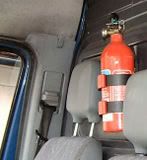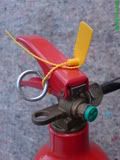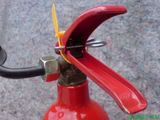GlesgaBill:
What changes have their been to the ADR Regs since 1/1/08 ?
Hi and Happy New Year GlesgaBill, Generally speaking, ADR is completely re-printed and re-published every 2 years. For some reason, it’s done on an odd-numbered year eg. 2003, 2005, 2007 etc.
The UK used to publish its own Regs for domestic use seemingly whenever parliament felt like it ![]()
Nowadays, the UK Regs are supposed to coincide with ADR, but the '04, '05 and '07 UK Regs were all late ![]()
![]()
(There weren’t any UK Regs issued in '06)
GlesgaBill:
I seem to remember that the amounts of powder in fire extinguishers carried on vehicles over 7.5 tonne will change TO the current-Min 2Kg in the cab
12kg on the body of the vehicle (one must be a minimum of 6kg)
GlesgaBill, I only changed one word in your quote above. ![]()
Previously, it depended upon when the vehicle was registered, and since that “transitional period” is now over, it would be confusing to put what the position WAS. ![]()
Since I haven’t covered fire extinguishers for ADR work before, like the batteries above, thanks for the question ![]()
As from 01/01/08, the requirements for fire extinguishers are:
Carriage in Limited Quantities. (Per individual package)
IF you’re carrying Limited Quantities (LQs) you don’t need any extinguishers.
IF you carry LQs with extinguishers on board, then that’s OK, since you’d have more than the minimum of nil. 
Carriage below threshold. (= total weight/literage of all packages on vehicle not exempted by LQs)
IF you’re carrying a load that’s NOT packaged in LQs, but below the threshold, then you’ll need:
1 X 2kg dry powder extinguisher suitable for fighting a fire in the engine or the cab of the vehicle.
Something like this:
 or this
or this 
In larger vehicles than those shown in the pics, the 2kg extinguisher can be mounted on the framework below the driver’s seat.
Carriage in excess of ADR threshold ( ie, when ADR applies in full)
You’ll need the 2kg extinguisher as above, PLUS one more extinguisher depending on the permitted G.V.W. of your vehicle as follows:
(The actual weight of goods that you’re carrying is irrelevant here ![]() )
)
Permitted G.V.W. less than 3,500 kgs needs ANOTHER 2kg extinguisher as above, making a total of 4kgs.
Permitted G.V.W. between 3,500kgs and less than 7,500kgs needs ANOTHER 6kg extinguisher making a total of 8kgs
Permitted G.V.W over 7,500kgs ie ANY LGV needs ANOTHER 10kg extinguisher making a total of 12kgs
Once the vehicle is an LGV, it doesn’t matter whether it’s a rigid, wag and drag or an artic ![]()
On most vehicles, the larger of the extinguishers is carried outside the vehicle in some kind of protective covering,
something like this:
Other requirements:
-
Extinguishers must be of an approved type ie. the Kite Mark or the CE mark.
-
Extinguishers must be periodically inspected and bear a label / sticker showing the next due date of inspection
-
Extinguishers must be fitted with a seal AND pin
Something like this:


-
Extinguishers must be protected from the effects of the weather.
-
Extinguishers must be easily accessible.
Lately, extinguishers are failing their inspection, if any of the paint is missing, since this leads to corrosion.
The old requirements (1 X 2kg + 1 X 6kg for all vehicles) means that there’s no end of 6kg extinguishers knocking about in yards up and down the country, so my advice is that you just need another extinguisher box mounting on the vehicle. Then you just put another of the old 6kg jobbies in ther and away you go, provided it’s compliant, of course.
That’s much cheaper than going out and buying a fancy 10kg extinguisher, because if you take my suggestion, you’d then have 2 + 6 + 6 = 14. With the minimum requirement being 12kgs, there’s no problem in being 2 kg to the good.
![]() Remember, 12kg is a minimum, not a maximum.
Remember, 12kg is a minimum, not a maximum. ![]()
In the event that 1 and 2 and 3 above aren’t complied with, you’ll be done for not having an extinguisher, since that’s the spec for extinguishers. You’ll also receive a Prohibition Notice (PN,) which probably won’t be cleared until there’s another compliant extinguisher on board. If you are on an international journey, you’ll be prohibited until you’re compliant, but you must reckon on being fined. ![]()
GlesgaBill:
and are there other changes that we should be aware of?
There’s a few bits and bobs, but they’re dependant on the substance.


